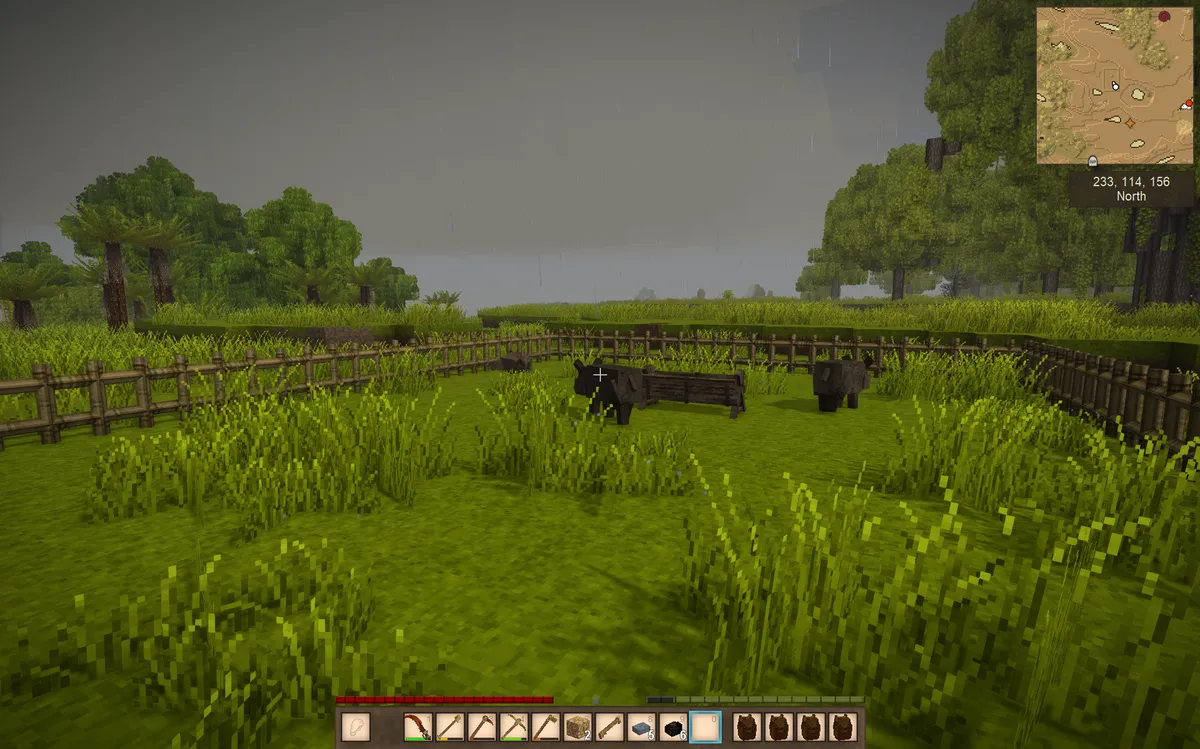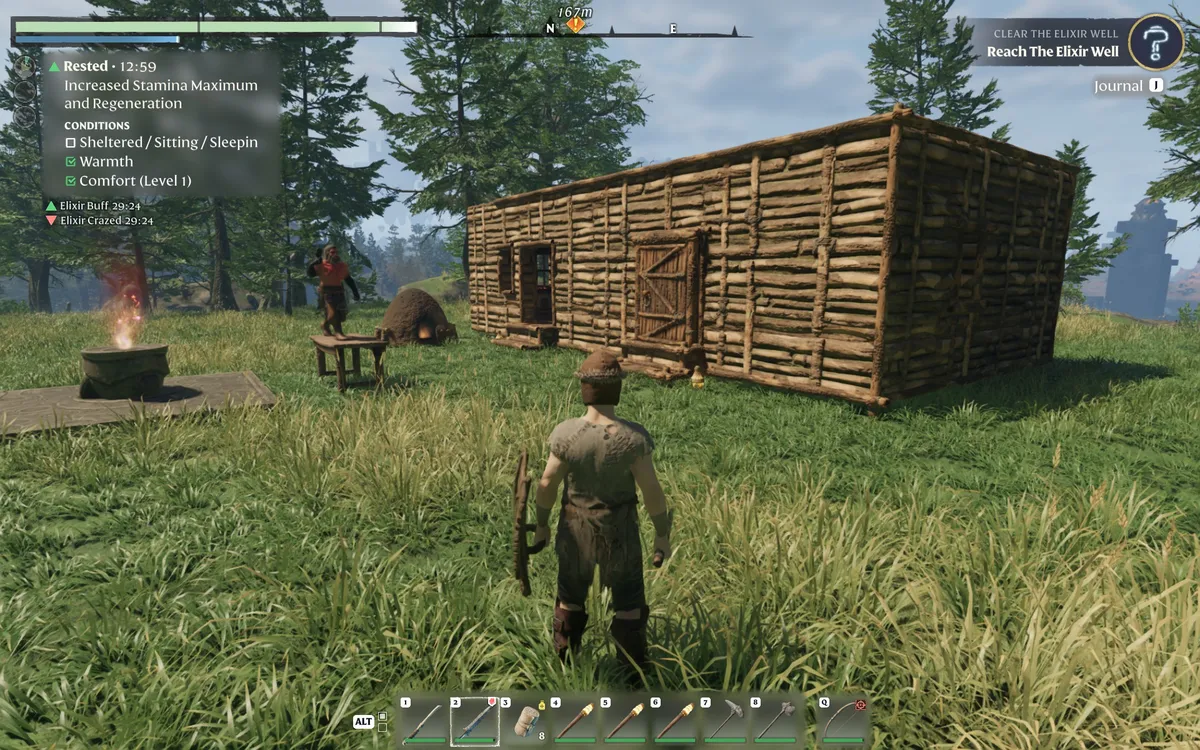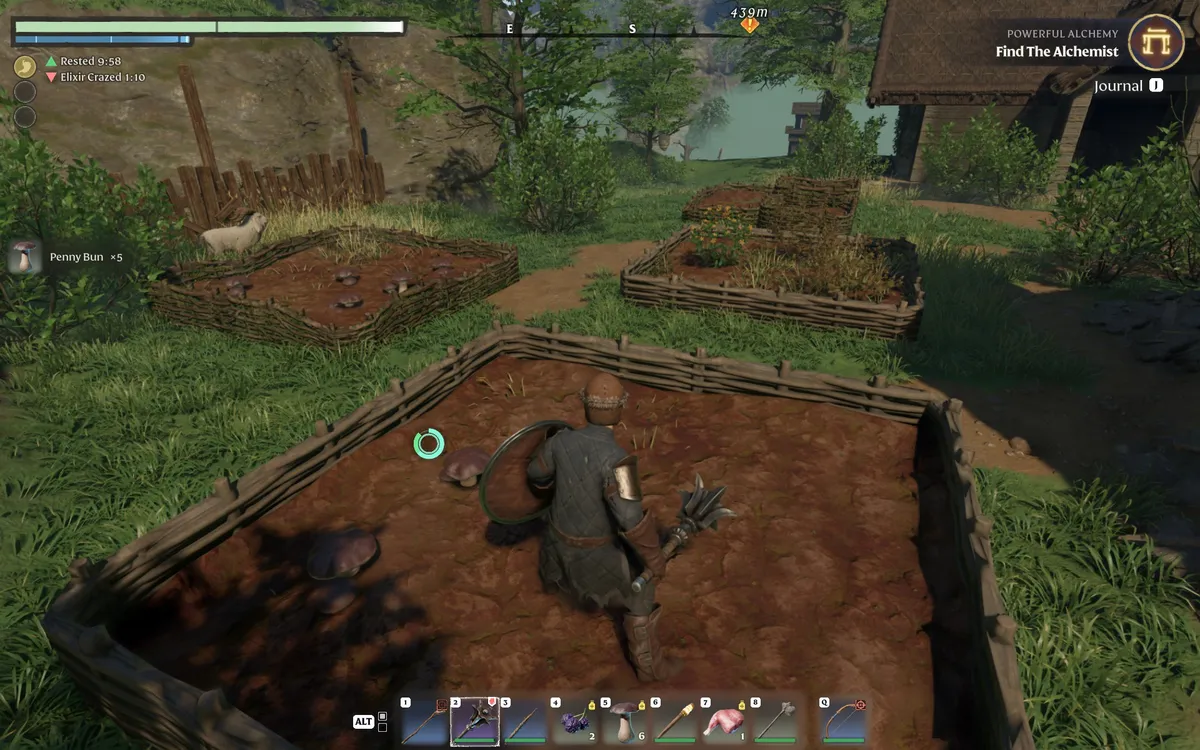Wolf Meat
I don't write much about "open world survival craft" (as Steam calls the genre) games here, but they are one of my favorite genres and I play tons of them. I don't know where you go to read people talking about this genre, but it's huge, and it's got a ton of weird little trends in it.
I like to call them "survival construction" games, because I think that points better at what makes them both different from other genres, and similar to each other. A lot of these games heavily borrow both survival mechanics and construction UX/UI strategies from their competitors in the same genre. They're also very strongly influenced, of course, by Fortnite, which has popularized a logic of construction that bazillions of people all over the world are now familiar with.
One of the survival trends I've seen some of these games doing is separating herbivore/passive mob "meat" from predator or "wolf" meat. It's something you can find in both Vintage Story and Enshrouded - two games which occupy the furthest-apart ends of the vibe spectrum in this genre. Vintage Story is very life-sim-y, while Enshrouded is an action RPG which incorporates a subset of Valheim-y mechanics. These two games chose to do opposite things with wolf meat because they are trying to accomplish very opposite experiences within the same genre.
You can tell a lot about what a game is trying to do when you take a close look at its wolf meat!
Meat and Farming
In Vintage Story, a standalone game heavily inspired by the TerraFirmaCraft Minecraft mod, predators like wolves, foxes, and bears drop "bushmeat." Bushmeat cannot be used in cooking recipes. Recipes dramatically increase any ingredient's healing and satiety value, so meat which cannot be cooked has very low utility to the player. If you are getting a lot of uneaten bushmeat clogging up your inventory, you might as well throw it out in favor of collecting the items which can be cooked.
The reason why Vintage Story does this is pretty clear: it is to prevent the player from adopting a playstyle primarily focused on fighting enemies. The game has many robust farming systems, and the "survival" fantasy of Vintage Story is about creating a homestead and investing a ton of time and resources into it. If you could sustain yourself with combat, there would be no reason to participate in the time-intensive farming mechanics, and they'd feel pointless and sloggy. But since combat with predator animals is often purely a resource drain, partially thanks to bushmeat, farming remains appealing - meditative and stoic and prudent, rather than distracting and slow.
The game goes even further to entice the player into the farming experience. Each food group - protein, grain, dairy, vegetable, and fruit - can add additional health segments to your health bar if you eat enough of it, so you need to eat a balanced diet. Farming is the only practical way to regularly access all these food categories and keep your health bar maxed out. Red meat and poultry can both be farmed and cooked.

Food is also extremely difficult to store in VS. Raw meat rots quickly, and it costs a lot of time and resources to create the storage vessels which can preserve it (for only a few days longer). Until you have a sizeable farming operation, a single piece of red meat is supposed to be quite difficult to get, and once you have it, you have to eat it quickly. This makes it feel special.
The fantasy of survival in this game is supported by this cultural understanding that we have of meat being a valuable and deeply nutritious substance. Despite meat's modern accessibility, Vintage Story wants meat to feel like many of us imagine it must have felt to our great-great grandparents: rare, important, and hugely beneficial.
Of course, each culture thinks of meat differently. Deriving as it does from Minecraft, Vintage Story's fantasy of survival is mostly a kind of European-derived fantasy. There are non-European plants and animals in the game, but the farming mechanics for rice, pineapples, etc. are not realistic, and largely copy the same farming mechanics pioneered for growing wheat in Minecraft: slap it down and make sure it's wet. Animals, like in Minecraft, are farmed in stationary pens. So you'll rarely see a player choosing to play as a nomad.

The value of "red meat" versus "bushmeat" is a foundational part of this. Without the nerf to wolf meat, the whole fantasy would fall apart!
Wolf Meat and Combat
Enshrouded is a much more typical "open world survival craft" game set in a static map and featuring a fairly directed quest chain and many hand-authored combat challenges. It focuses very heavily on combat and exploration and has very perfunctory base-building.

Enshrouded demonstrates its focus on exploration and traversal by including one bazillion forms of traversal, many of which I could honestly do without: sprinting, gliding, double-jumping, grapple-hooking, and so on. A game which wants you to meditatively farm would simply not include movement mechanics like these!
Despite all this, Enshrouded does, actually, include farming and recipe-cooking. Neither is unlocked at the start of the game, and it actually takes a pretty long time to get to them during a playthrough. Until you unlock the Farmer NPC - which can take many hours - you're stuck eating the things you find in the world, like meat from animals.

There are only two types of meat in the early game (the first 10+ hours, depending on how you play): "lean meat," dropped by passive animal mobs such as sheep, and "wolf meat," dropped by wolves. This game uses Valheim Logic for its food system: each food you eat extends your health bar, and you have a limited number of foods you can eat before becoming "full" and losing the ability to eat anything else.
But in Enshrouded, unlike Valheim, you can have only one food from each food group. So you've gotta choose between your two meats. Lean meat gives you a sizeable health bar chunk and +1 constitution, but wolf meat gives you that health and +2 constitution. You can use only one type of meat, and wolf meat is flatly better than peaceful-creature meat.
It's gotta be. This is a game about running around the world slapping enemies with your sword and jumping off cliffs. The game wants to reward you for getting into fights, so if you fight a wolf and win, of course the meat you earn from that should be better than the meat you earn from killing a defenseless sheep!
This is simply a traditional RPG itemization strategy living inside a "survival" game. Just as you'd swap out gear in most RPGs, you swap out equipped food. Just as the late-game enemies in a classic RPG might drop more powerful crafting ingredients, etc, Enshrouded's late-game animal enemies drop more useful meats. Valheim does precisely this same thing - every food that takes more progress, skill, armor, and weapons to find is stronger than the food which came before.
Vintage Story does not do this! Pigs, sheep, and rabbits drop red meat, and chickens drop poultry. All red meat is the same, and all poultry is the same. Vintage Story is a life sim, with nutrition mechanics, and it is trying to get you to buy into the fantasy of subsistence farming all your food groups, So any meat you get through farming is fantastic, and any meat you get through exploration and combat sucks.
Enshrouded, on the other hand, is not a life sim - it is an open world action RPG wearing Valheim's face as a mask. For much of the average playthrough, it feels like a survival/basebuilding game in aesthetics only, to appeal to people who loved that gameplay in Valheim. These two games are doing completely different things, so their Meat Logic is opposite. Enshrouded must reward the fantasy of Number Go Up, so meat is one of the number that do go up.
Some foods are just better than others
Both of these games address the belief that some raw food ingredients are simply more nutritious than others. Just as we might go to the grocery store and choose between a regular chicken breast and an organic one, survival videogames are full of meats that are simply better than other meats. Meat Progression is real for us in the real world - culturally, anyway, if not always 100% factually. Why shouldn't we see this belief reflected in games?
So it's quite unusual within this genre for Vintage Story to include such elaborate farming mechanics, but to refuse an involved Meat Progression mechanic, or to refuse to distinguish between different varieties of red meat. After years of content updates, Minecraft currently has ten kinds of meat. In Valheim, every creature which drops meat drops a unique meat type. Vintage Story just has poultry, red meat, bushmeat, and fish.
Farming in Vintage Story is so weird and slow and involved that I cannot help but admire it. It's harder and slower and more tedious to farm in VS than it is in Valheim, my previous winner of the most-tedious-farming award. But people are glad to farm in VS anyway, because there's an immense satisfaction in building all that infrastructure, breeding your pigs, sheep, and rabbits to become tame, and finally getting to the point (three generations down the line!) where they can be easily butchered without putting up a fight, and then dumping all those animals' undifferentiated red meat into a stew.
Rewards
Games get us to do weird shit all the time. They just make the things they want us to do more rewarding than the things they don't want us to do. This is not a deep observation.
But this does get interesting when the genre you are talking about is a fusion of RPG and life sim mechanics - a whole genre of vaguely prepper-y solo-survival simulators which are struggling to be both escapist and "realistic."
These are games which satisfy the fantasy that you could live off the grid, and could be completely self-sufficient, owning the entire vertical production process for every little bit of clothing you wear, and every bite of food you eat. They reward you for embracing and enacting this belief. They make a ton of implicit arguments about what life is like, or should be like, in a way that RPGs without survival or basebuilding mechanics do not.
I love this genre and I wish people talked about it more often! There are so many kids out there drinking this stuff in. If a kid plays CoD, they've probably already soaked for a decade or more in messages about the military shared by movies, family members, and school. If a kid is playing Minecraft or Valheim or Vintage Story or Enshrouded, however, that might be the only entertainment media in their life that has something specific to say about mining, ranching, nutrition, or construction. There just aren't a lot of kids' movies out there about what it's like to build a cellar or butcher a pig.
It's just cool! It's cool these games exist. I especially love it when they make no sense and contradict one another!